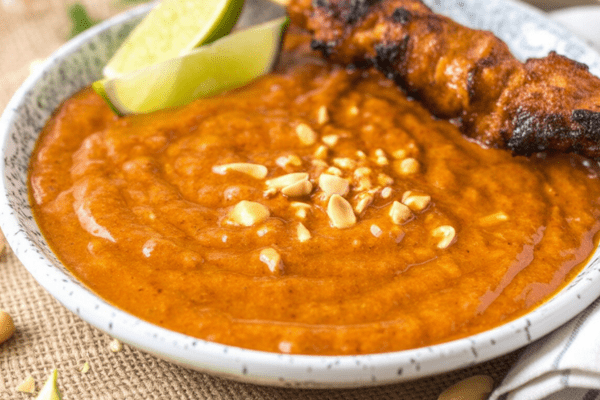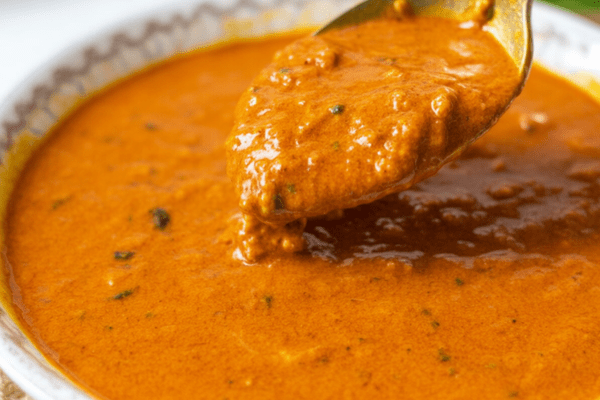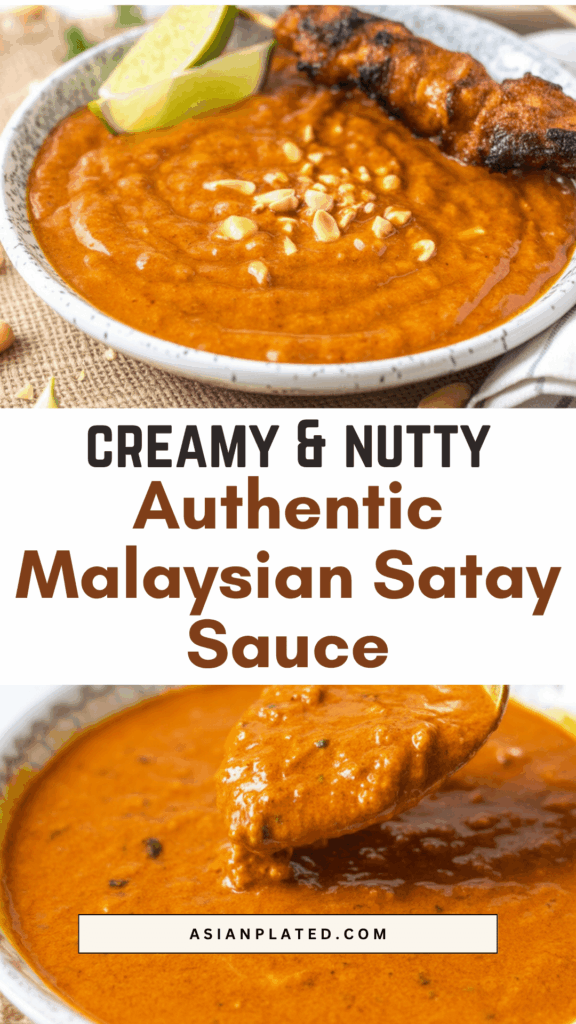After making this deeply flavorful, nutty, and aromatic Malaysian satay sauce, you may never want the bottled stuff again. Let me show you why this sauce is so special, while sharing my own experiences and tips for making it at home—even if you don’t have a Southeast Asian grocery down the street.

What Is The Difference Between Malaysian And Thai Peanut Satay Sauce?
These two sauces might seem similar at first glance, but they’re like cousins with distinct personalities. Malaysian satay sauce leans heavily on fresh aromatics—lemongrass, galangal, coriander—and less on coconut milk, so it has a more herbal, earthy depth.
When I first tried making Thai-style peanut sauce at home, I was surprised at how creamy and coconut-heavy it was. Delicious, of course—but it felt more like a dip than a full-flavored sauce. Meanwhile, Malaysian satay sauce reminds me of backyard grills growing up, where the scent of caramelizing peanuts and lemongrass would drift through the air.
If you want that street-food-style punch of herbs and peanuts, the Malaysian version is what you’re after.
Why You’ll Love This Recipe
I can’t tell you how many times I’ve made this sauce for friends who’d never tried anything like it before. The reaction is always the same: “What’s in this? It’s amazing!”

Authentic flavors
This recipe hits all the right notes I remember from the satay stalls of my childhood. Sweet, salty, slightly spicy, nutty, and aromatic—it’s the kind of sauce that makes even simple grilled chicken taste special.
Simplified ingredients and method
Look, I don’t always have time to toast peanuts from scratch and pound a spice paste in a mortar for 30 minutes. I streamlined this to use store-bought toasted peanuts, a small food chopper, and common ingredients. Even if you live nowhere near an Asian market, you can get pretty close to the real deal with smart substitutions.
When we moved to a place without any Asian restaurants, I had no choice but to recreate my favorites at home. It taught me to improvise without sacrificing flavor. That’s the spirit behind this recipe: maximum payoff, minimum fuss.
Ingredients For This Recipe
Here’s what you’ll need, plus a little behind-the-scenes on why each is special and how you can work with what you have:
Chilies
Fresh or dried—whatever you have. I often use fresh Thai chilies from the farmers market in summer, or even mild jalapeños if that’s all I can find. The heat is adjustable, so you can make it family-friendly or give it a proper kick.
Lemongrass
This is non-negotiable for me. It’s the signature scent of Malaysian cooking. I usually buy a big bundle, chop and freeze it. Frozen works perfectly and saves trips to specialty stores.
Galangal
I keep a bag of sliced galangal in the freezer. When I first moved away from home, I had to settle for extra ginger, which is a fine stand-in, but galangal really makes it authentic with its piney citrus note.
Peanuts
Dry-roasting and peeling peanuts is traditional, but honestly, I often use unsalted roasted peanuts from the bulk bins. It’s so much faster, and the flavor is still fantastic.
Concentrated tamarind or lime juice
Tamarind is the classic sour element, but lime juice is my go-to in a pinch. It brightens the whole sauce. I always say: don’t skip the acidity—it’s what balances the richness.
Fish sauce and soy sauce
I know fish sauce can be divisive. If you’re vegetarian or just not a fan, a bit of extra soy sauce works too. But I love how fish sauce brings that subtle briny depth.

Step-By-Step Instructions
These instructions are simplified for busy home cooks without sacrificing authenticity.
Step 1: Prepare the peanuts
When I first tried this recipe, I over-blended the peanuts into paste. Don’t do that! I’ve learned to pulse carefully for that chunky, rustic texture.
If you’re toasting your own peanuts, let them cool fully before blending. I once rushed this and ended up with soggy, oily clumps. Lesson learned.
Step 2: Make the base paste
This is the aromatic powerhouse of the sauce. I used to try chopping everything by hand, but the food processor is my best friend here.
Step 3: Cook the base
Don’t rush this step. Cooking until the oil separates is a classic Southeast Asian technique—it’s what gives the sauce that deeply cooked, layered flavor. When I first started, I didn’t understand what this meant, but once you see the oil glistening around the edges, you’ll know you’ve nailed it.
Step 4: Add the rest
After adding peanuts, coconut milk, and seasonings, simmer gently. My kitchen always smells incredible at this stage—like I’m back home.
Recipe Expert Tips
- Cool the peanuts before blending
Warm peanuts release too much oil and turn to paste. Trust me, this step is worth the wait. - Pulse in small batches
A big batch tends to leave half chunky and half powdery. I’ve had to dig out half-blended clumps more than once before learning to do it in small amounts. - Understand ‘oil separating’
This isn’t fancy jargon—it’s your cue that the aromatics are properly cooked. When the oil peeks through, that’s when the flavor is deepest. - Use a splatter guard
I learned this one the hard way. Satay sauce has a tendency to bubble and spit as it reduces. Unless you love scrubbing sauce off your backsplash, cover the pot partially.
How To Serve, Store, And Freeze
Serve
I serve this with grilled chicken skewers most often, but I also love it with grilled tofu or even roasted vegetables. It’s so good spooned over rice. When we have friends over for a backyard cookout, I set it out like a dip and watch everyone hover around it.
Store
I use glass jars or airtight containers and keep them in the fridge. It lasts about a week, but honestly, it rarely sticks around that long.
Freeze
Flattening in ziplock bags is my go-to trick. It freezes beautifully for up to six months, and you can snap off just what you need. Perfect for weeknight dinners when I want something special but don’t want to cook from scratch.
Reheat
It does thicken in the fridge. I just add a splash of water and warm it gently on the stove, stirring until it’s pourable again.
Authentic Malaysian Satay Sauce

Once you try this authentic Malaysian-style satay sauce, you'll never want to go back. This version is nutty, creamy, and full of balanced flavors like lemongrass, ginger, and warm spices.
Ingredients
Base
- 4 red chilies, sliced (adjust or omit to taste)
- 3 lemongrass stalks, white parts only, thinly sliced
- 1 inch ginger, sliced
- 1 inch galangal, sliced
- ½ red onion, sliced
- 4 garlic cloves
- 2 tablespoons coriander seeds
Main
- ⅓ cup (65 g) coconut oil, or any oil
- 1 lemongrass stalk, white part only
- 1 cup (150 g) roasted plain peanuts, or snack-type peanuts
- ½ cup (120 g) coconut milk
- 1½ cups (345 g) water
- ¼ cup (40 g) coconut sugar, or brown sugar
- 2 tablespoons low-sodium soy sauce
- 1 tablespoon fish sauce
- 1 tablespoon concentrated tamarind, or 1 tablespoon lime juice
- ½ teaspoon salt, to taste
Instructions
- Using store-bought toasted peanuts: Blend into a semi-fine texture using a grinder. Work in small batches for even blending.
- Toasting peanuts at home:
Pan method – Dry-toast over medium heat for 20–30 minutes, stirring to avoid burning.
Oven method – Bake in a single layer at 320ºF (160ºC) for 20–30 minutes.
Air-fryer method – Air-fry at 320ºF (160ºC) for 15–20 minutes, stirring once halfway through. - Remove skins by rubbing the peanuts with a kitchen towel. Cool completely before blending into a semi-fine texture.
- Blend chilies, lemongrass, ginger, galangal, red onion, garlic, and coriander seeds into a fine paste using a chopper or blender.
- Bruise the extra lemongrass stalk by bashing it with a rolling pin.
- Heat oil in a pot with the bruised lemongrass until sizzling. Add the base paste and cook until it thickens and oil separates, about 5–10 minutes.
Add ground peanuts, coconut milk, coconut sugar, tamarind, water, fish sauce, soy sauce, and salt. Stir well. Bring to a boil, then simmer for 10 minutes until oil separates again. Your sauce is ready!
Peanuts
Base
Cook
Notes
- Cool peanuts before blending if toasting yourself. This helps achieve the right texture and maintains crunchiness.
- Semi-fine texture is key. Small peanut pieces give a pleasant crunch—avoid over-blending into peanut butter.
- Blend in small batches for even results.
- Understanding "until the oil separates": This Southeast Asian method indicates doneness. At first, oil blends with ingredients, but with time, it separates—showing the ingredients are cooked through.
- Use a splatter guard to prevent mess and protect from splattering sauce during cooking.
Nutrition Information:
Yield: 3 Serving Size: 1Amount Per Serving: Calories: 250Total Fat: 9gSaturated Fat: 1gTrans Fat: 0gUnsaturated Fat: 7gCholesterol: 3mgSodium: 1210mgCarbohydrates: 43gFiber: 3gSugar: 9gProtein: 7g
Asianplated.com, occasionally offers nutritional information for recipes contained on this site. This information is provided as a courtesy and is an estimate only. This information comes from online calculators. Although allchickenrecipes.com attempts to provide accurate nutritional information, these figures are only estimates.
Recipe FAQs
What is the difference between satay sauce and peanut sauce?
Peanut sauce is a broader term—it can be as simple as peanut butter mixed with soy sauce and lime. Satay sauce is usually more layered, with cooked aromatics and herbs like lemongrass and galangal, and that signature “oil separates” technique for depth.
What can I use instead of fish sauce?
If you’re avoiding fish sauce, just use extra soy sauce with a squeeze of lime. It won’t have the same funky complexity but will still be delicious and umami-rich.
Try other recipes:

